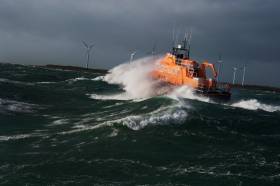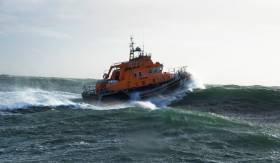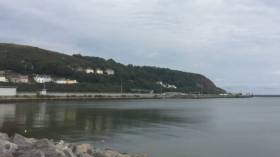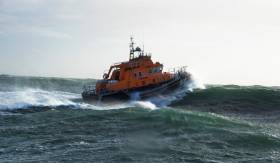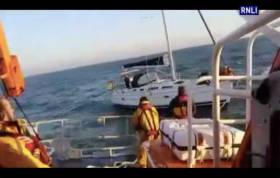Displaying items by tag: Rosslare Harbour
Aran Islands Lifeboat Crew In Medevac Of Injured Tourist
Aran Islands lifeboat volunteers launched their all-weather lifeboat on Saturday afternoon (17 August) to carry out a medical evacuation for an injured tourist.
The female visitor to Inis Mór had sustained a suspected fractured leg while out sightseeing, Aran Islands RNLI said.
The casualty was transferred safely aboard the Severn class lifeboat David Kirkaldy under coxswain Tommy Dirrane and a full crew, and was brought to the waiting ambulance at Rossaveal Harbour.
Dirrane said later: “The volunteer crew members train regularly to maintain their quick response time and that can make all the difference to the casualty you are going to help. We would like to wish the casualty a speedy recovery.”
Elsewhere on Saturday, Rosslare Harbour RNLI volunteers were called to assist a small yacht with two onboard in difficulty off Cahore Point off the North Wexford coast.
Tangled in a lobster pot line and unable to sail in the freshening south westerly wind, the crew called the Irish Coast Guard for assistance, according to the RNLI.
Rosslare Harbour RNLI volunteers launched their all-weather lifeboat and reached the yacht in a short time.
Lifeboat volunteers reached the yacht in short order and set up a tow line to bring it close to Cahore Harbour, where the Cahore inshore rescue boat took over due to the shallow water.
Rosslare Harbour RNLI coxswain Eamonn O’Rourke said: “I would like to commend our volunteer crew who worked hard to attach a tow to the yacht in challenging conditions. We were glad to see the vulnerable yacht and her crew safe.”
It was a busy August Bank Holiday weekend on the Wexford coast with three callouts for Rosslare Harbour’s lifeboat volunteers.
The first came on Saturday evening (3 August) at 6pm, when the lifeboat readied for launch to a report of a 10m yacht entangled in fishing gear some three miles from the harbour.
The stricken yacht, with four people on board, was quickly reached by the lifeboat as the seas were calm and a fine evening, according to Rosslare Harbour RNLI.
The all-weather lifeboat’s secondary craft was launched with two volunteers, who manoeuvred into position and managed to cut the yacht free, allowing its journey to continue.
The second callout was in the early hours of Sunday morning (4 August), following a 3am Mayday sent by a 17m schooner that was taking on water.
The tall ship and its complement of 10, including a number of children, were escorted safely back to the harbour by the lifeboat.
The third request for help came later on Sunday, when a small 4m boat with a lone injured person on board was found drifting by a passing freighter around 12 miles east of Tuskar Rock Lighthouse.
The casualty was airlifted to Waterford Hospital by the Irish Coast Guard’s Waterford-based helicopter Rescue 117.
Rosslare Harbour RNLI made an attempt to tow the small boat back to port, but the casualty vessel sank shortly after beginning the tow.
Rosslare Harbour Lifeboat Assists In Evacuation Of Ferry Passenger Taken Ill On Late Night Crossing
#Lifeboats - The RNLI’s all-weather lifeboat based in Rosslare Harbour was launched at 10.38pm on Saturday night (2 March) to assist a passenger onboard an Irish Ferries vessel bound for Pembroke in Wales.
The passenger ferry Oscar Wilde, which was located 20 miles off the Wexford coast at the time, asked for assistance in evacuating a passenger who had become ill.
Sea conditions were unfavourable for the volunteers on the Rosslare Harbour lifeboat to go alongside the ferry.
The Irish Coast Guard helicopter Rescue 117 from Waterford was also tasked and quickly arrived on scene. After attempts to airlift the casualty it was deemed too dangerous.
The Oscar Wilde returned to Rosslare Europort at 1am, where an ambulance was waiting to bring the casualty to hospital. The RNLI volunteers in their Severn class lifeboat stood by the passenger ferry for the duration.
Sea conditions were very poor at the time, with a strong Force 7 to 8 gale and heavy rain.
Coxswain Eamonn O’Rourke commented that the volunteer crew of the lifeboat had to endure very challenging conditions.
Speaking afterwards, Rosslare Harbour RNLI lifeboat operations manager David Maloney said: “Conditions at sea tonight were challenging for our coxswain and lifeboat crew and I would like to commend them for their efforts in enduring a rough passage in the dark, and late at night on a Saturday evening, to be of assistance.”
South Wales Ferryport of Fishguard 'Losing Out' to Pembroke Dock
#FerryNews - In south Wales, the former leader of Pembrokeshire County Council has said Fishguard is losing out to Pembroke Dock because the A40 road to the port is so bad.
As BBC News reports, Councillor John Davies wants the Welsh Government to fund the widening of the A40 all the way to Fishguard.
The Stena ferry company has dropped a £5m upgrade for Fishguard, described as a "worrying" move by local politicians.
But Welsh Government minister Baroness Eluned Morgan said there was less money for roads because of austerity.
For more on this story, click the link.
#RNLI - Rosslare Harbour RNLI’s all-weather lifeboat launched late last night (Sunday 27 May) to assist a becalmed yacht with three crew onboard.
The 13m yacht, which was travelling south, was becalmed on a very still evening. Unable to continue and within busy shipping lanes off the Wexford coast, the yacht called for assistance.
Rosslare Harbour RNLI lifeboat quickly reached the yacht and it was brought back under tow to the shelter of Rosslare Europort.
Apart from poor visibility due to fog, sea conditions were calm.
Speaking after the callout, Jamie Ryan, Rosslare Harbour RNLI volunteer lifeboat press officer, said: “We would like to commend our crew for their great response late on a Sunday evening and also commend the experienced crew on the yacht for quickly calling for assistance when they encountered problems.”
Earlier, Baltimore RNLI launched on its third callout in as many days to assist a yacht which went aground on East Skeam Island yesterday afternoon.
The yacht, with two on board, had been dragged by its anchor dragged in a strong north-easterly Force 5 wind and ended up ashore on the West Cork island.
Arriving in scene seven minutes after launch, the Baltimore lifeboat crew established a tow to refloat the yacht and send it on its way to Schull.
On return to Baltimore harbour, the lifeboat crew then went to investigate a 16ft dory that had broken from its mooring and gone ashore on Sherkin Island.
No people were on board, so the lifeboat crew took an anchor from the vessel and dropped it offshore from the beach so that the rising tide and onshore winds wouldn’t drive the boat further ashore.
#RNLI - Rosslare Harbour RNLI launched yesterday afternoon (Saturday 5 May) to help a Dutch tourist when his motorboat lost power 10 miles north of the Co Wexford port.
The sole occupant of the 33ft motorboat was a Dutch man who was travelling from Dun Laoghaire to Cork when his vessel lost power and he ran into difficulty.
The lifeboat crew responded to the call at 1.55pm and were quickly on scene to establish a tow.
Conditions were good for the journey back to land; there was a slight haze but the sea was calm.
The lifeboat crew towed the vessel back to the Fisherman’s Wall in Rosslare Harbour and the tourist was welcomed ashore.
Commenting on the callout, Rosslare Harbour RNLI lifeboat operations manager Dave Maloney said: “It was perfect conditions for a callout. As the man was travelling on his own we put one of our lifeboat crew onboard to help establish the tow and to check everything was okay.
“Thankfully it was nothing too serious and we were able to bring him safely to Rosslare where he could get his vessel seen to and hopefully continue on with his journey.”
The RNLI and Irish Coast Guard issued a joint call earlier this week for people to stay safe on or near the water this May Bank Holiday weekend, as previously reported on Afloat.ie.
#NewsUpdate - A delivery of the first imported animal feed in response to the deepening - and now nationwide - fodder crisis has arrived in Rosslare Harbour.
The feed reports RTE News, which has been imported from Britain, will then be distributed by Dairygold Co-Op to ten locations around Munster.
Further significant imports are scheduled for the coming days, with Glanbia and Lakeland Dairies saying that they have also sourced animal feed abroad for their members.
The Dairygold Co-Op executives who sourced and organised the first 2,500 tonnes of animal feed in response to the deepening weather-related shortage are attempting to locate even more supplies to distribute to their farmer members.
Seamus O'Mahoney, Head of Sales at Dairygold Argi Business, said around 3,500 bales are expected to arrive at Rosslare Port over the next two to three days.
Speaking on RTÉ's Morning Ireland, he said imports from the UK were inevitable given the current situation facing farmers.
"We have been seeing over the last few months that farmers have been trying to stretch existing fodder and we have had a very long winter, two storms, a late spring. Farmers didn’t have a chance to put out fertiliser and all of those factors didn’t click," he said.
Click HERE for more on the farming crisis.
Rosslare Harbour Lifeboat In Extensive Search For Swimmer Reportedly Swept Out To Sea
#RNLI - Rosslare Harbour RNLI was involved in an extensive search off the Wexford coast yesterday (Tuesday 1 August) after a swimmer was reported to have been swept out to sea.
The alarm was raised shortly after 3pm by a member of the public who reported what they thought to be a swimmer being carried out to sea from Rosslare Strand.
The all-weather lifeboat, under coxswain Eamonn O’Rourke, launched at 3.15pm and began an extensive search. The Irish Coast Guard helicopter Rescue 117 from Waterford was also tasked.
Weather conditions were good for searching, with a south west Force 4 wind blowing.
Following a four-hour search, the volunteer crew were requested to stand down the lifeboat at 7.30pm, with no one reported missing and no one found.
Speaking following the callout, Rosslare Harbour RNLI lifeboat press officer Jamie Ryan said: “We would like to commend the member of the public who raised the alarm today. That is the right thing to do if you think someone has got into difficulty on the water.”
Rosslare Harbour RNLI rescued three men yesterday evening (Monday 3 July) after their boat ran aground.
The volunteer lifeboat crew was requested to launch their all-weather lifeboat at approximately 4.30pm following a report from the Irish Coast Guard that a vessel had ran aground on the east side of Blackwater Bank.
The lifeboat under Coxswain Art Shiel and with six crew members onboard launched at 4.40pm and made its way to the scene, arriving at 5.20pm.
Cahore inshore lifeboat was also tasked and was on scene first.
Weather conditions at the time were described as good with a moderate breeze.
The 37ft–motorsailer with three men on-board had ran aground and broke her steering.
Once on scene, the lifeboat crew worked with the Cahore inshore lifeboat crew to get the vessel off the bank which they managed to do at 6pm. All onboard were safe and well.
Two lifeboat crew members transferred onto the casualty vessel and a towline was established. The lifeboat then proceeded to tow the motorsailer back to Rosslare Harbour.
Speaking following the call out, David Maloney, Rosslare Harbour RNLI Lifeboat Operations Manager said: ‘The crew onboard the vessel did the right thing this evening and raised the alarm when they got into difficulty. We would encourage anyone planning a trip at sea this summer to go prepared and to always respect the water. Should you get into trouble, the RNLI provides a 24-hour search and rescue service and our volunteers in Rosslare are always willing and ready to respond to help anyone in need.’
#RNLI - Rosslare Harbour RNLI assisted three men onboard a yacht yesterday evening (Wednesday 3 May) after it got into difficulty off the Wicklow coast.
The all-weather lifeboat, under coxswain Eamonn O’Rourke and with six volunteer crew members onboard, launched at 6.40pm to the 13m yacht, which developed engine problems while travelling north.
The yacht’s progress was further hindered by the difficult weather conditions, with a strong north-easterly wind blowing Force 6-7.
After reaching the yacht off the Wicklow coast, the lifeboat crew proceeded to take it on tow and headed to the port of Arklow.
Arklow RNLI’s all-weather lifeboat, which had completed another callout at the time, met the vessels and was able to take over the tow, continuing on to Arklow.
Speaking after the callout, Rosslare Harbour RNLI volunteer lifeboat press officer Jamie Ryan praised the efforts of the volunteers who had to endure some challenging sea conditions.
“As we continue to enjoy the good weather and enter into the main boating season, we would remind all those taking to the sea over the summer months to respect the water.
“Always wear a lifejacket and always have a means for calling and signalling for help, ensuring everyone onboard knows how to use it.
“Always check the weather forecast and tide times and make sure someone ashore knows where you are going and who to call if you don’t return on time.”
The rescue came less than a week after Rosslare Harbour’s all-weather lifeboat went to the aid of a yacht with a broken mast off Tuskar Rock, as previously reported on Afloat.ie.



























